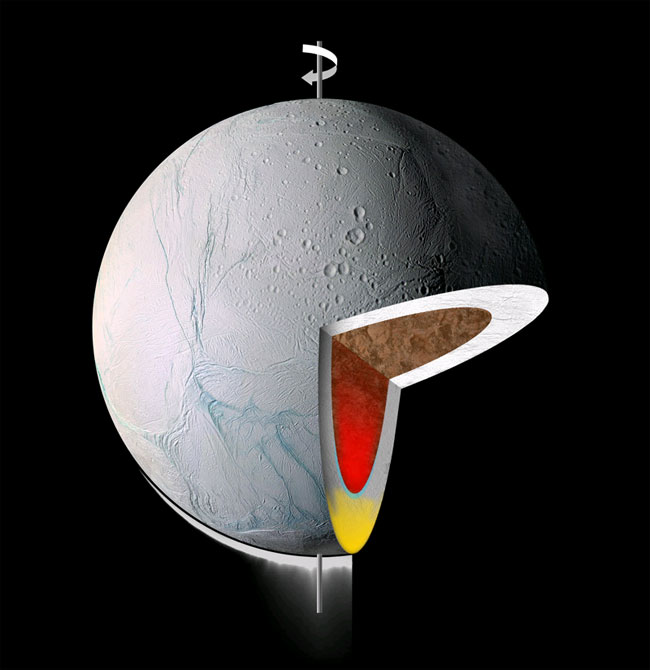
Slushy water geysers on Saturn's moon Enceladus might be powered by the grinding of ice sheets against one another and the periodic widening of rifts on the satellite's surface.
Results from two new studies, detailed in the May 17 issue of the journal Nature, support the idea that a process called "tidal heating" is responsible for plumes of water vapor and ice crystals recently observed spouting from the moon's unusually warm south pole.
Enceladus is a small gray-white world coated in ice. Its surface is pockmarked by craters and scoured by pale blue fractures resembling veins. Called "tiger stripes," these fractures mark the boundaries between enormous ice sheets that encase the planet like a shell.
NASA's Cassini spacecraft recently observed geysers erupting from the tiger stripes into space. The most active tiger stripes are clustered around a mysterious hot spot recently discovered on the moon's south pole.
Grinding ice sheets
Using computer models, researchers led by Francis Nimmo of the University of California, Santa Cruz found that ice sheets grinding against each other at tiger stripe fractures generate enough heat to melt some of the ice. The melted ice would sublimate into water vapor and float directly into space.
"If the two sides of the fault rub backwards and forwards against each other, you generate heat, just like you get heating if you rub your hands together," Nimmo told SPACE.com.
Get the Space.com Newsletter
Breaking space news, the latest updates on rocket launches, skywatching events and more!
Another model, created by researchers led by Terry Hurford of the NASA Goddard Space Flight Center, suggests the tiger stripes might also open and close periodically, like enormous valves, to allow volatile material trapped beneath the ice to escape to the surface.
The researchers say their two mechanisms complement each other. "There's two different things going on and they're happening simultaneously," Hurford said in a telephone interview.
Tidal heating
Both teams think their mechanisms are driven by Saturn's uneven gravitational pull on Enceladus as it revolves around the planet. Because its orbit around Saturn is elliptical, the moon is closer to Saturn at some points of its orbit than others and the force of gravity it feels from the planet varies with distance. When Enceladus is closest to Saturn, gravity causes a bulge to form on the side of the moon facing the planet; the bulge shrinks as the moon moves farther away. Like a repeatedly bent paperclip, the constant motion on Enceladus generates friction and heat.
This phenomenon, called "tidal heating," could drive the opening and closing of the tiger stripes and also cause the ice sheets to flex and grind against each other, the researchers speculate.
"The thing that's driving everything is the [tidal forces] that are opening and closing the cracks and moving the faults backwards and forwards," Nimmo said.
Both ideas could be confirmed with further observations by Cassini or other spacecraft. For example, tidal heating should only cause the tiger stripes to open at certain times during the moon's orbit around Saturn. And Nimmo's team predicts that some portions of the tiger stripes should be more active than others.
"The amount of backwards and forwards motions you get depends on the direction the tiger stripes are pointing in, so different areas of the tiger stripes ought to have different motions and different temperatures," he said. "We're predicting which bits of the tiger stripes are going to be hottest."
A hidden ocean
Nimmo's team also estimates the ice shell on Enceladus is at least 3 miles (5 km) thick and that a vast, deep ocean is tucked beneath it.
"If the ice [shell] was coupled directly to rock, it can't roll around very much," Nimmo explained. "But if you put an ocean in between, the ice can move around much more and you can get more heating."
Andrew Dombard, a researcher at Johns Hopkins University who was not involved in the studies, wrote in an accompanying Nature article that the new models "provide complementary descriptions of how gravitational forces might help to form the plumes of water vapor" on Enceladus, but that they "describe only how the satellite is behaving, not why."
Dombard notes that even though the orbit of Mimas, another icy Saturnian moon, is much closer to Saturn and more eccentric than that of Enceladus, it is much less geologically active.
"Why Enceladus has ended up in such an active state whereas Mimas has not are questions that will exercise planetary scientists for some time to come," Dombard wrote.
Join our Space Forums to keep talking space on the latest missions, night sky and more! And if you have a news tip, correction or comment, let us know at: community@space.com.
Ker Than is a science writer and children's book author who joined Space.com as a Staff Writer from 2005 to 2007. Ker covered astronomy and human spaceflight while at Space.com, including space shuttle launches, and has authored three science books for kids about earthquakes, stars and black holes. Ker's work has also appeared in National Geographic, Nature News, New Scientist and Sky & Telescope, among others. He earned a bachelor's degree in biology from UC Irvine and a master's degree in science journalism from New York University. Ker is currently the Director of Science Communications at Stanford University.









